Seventh in a series of interviews with participants at the 2009 Association of Tropical Biology and Conservation (ATBC) conference.
A large flying fox eats a fruit ingesting its seeds. Flying over the tropical forests it eventually deposits the seeds at the base of another tree far from the first. One of these seeds takes root, sprouts, and in thirty years time a new tree waits for another flying fox to spread its speed.
In the Southeast Asian tropics an astounding 80 percent of seeds are spread not by wind, but by animals: birds, bats, rodents, even elephants. But in a region where animals of all shapes and sizes are being wiped out by uncontrolled hunting and poaching—what will the forests of the future look like? This is the question that has long occupied Dr. Richard Corlett, professor of biological science at the National University of Singapore.
 Richard Corlett. Photo courtesy of Richard Corlett. |
Corlett, a British native, has lived in Southeast Asia for thirty years giving him a unique perspective on the changes forests have undergone recently.
“The destruction and degradation of forest ecosystems in tropical East Asia has a whole over the last 30 years has been simply appalling. Thirty years ago there were still large, near-pristine areas with more or less intact faunas: now almost everywhere is degraded and even the best-looking forest has lost some or all of its large vertebrates to hunters,” Corlett told Mongabay.com.
Already fragmented and degraded, Southeast Asian tropical forests require seed dispersing animals more than ever to move seeds from one forest patch to another. But in the near-future another threat will make seed dispersers even more important.
“As the climate changes, plant populations must adapt, move or die, and seed dispersal is the only way to move. Outside the tropics many plant species have moved towards the poles or to higher altitudes as a result of warming over recent decades. Changes within the tropics have so far been relatively small, but the much larger changes predicted for the next 50-100 years will almost certainly require tropical plant populations to migrate,” Corlett explains.
Two key animals for moving seeds large distances are the flying foxes and fruit pigeons, however both are targets of hunters. Flying foxes, once incredibly abundant, are vanishing from Southeast Asian forests due to unmanaged legal hunting. A recent study predicted that the large flying fox (the world’s largest bat) will face extinction in 6-81 years due to hunting.
“The decline in flying fox populations is one of the most conspicuous changes in the region in the 30 years I have been here,” Corlett says.
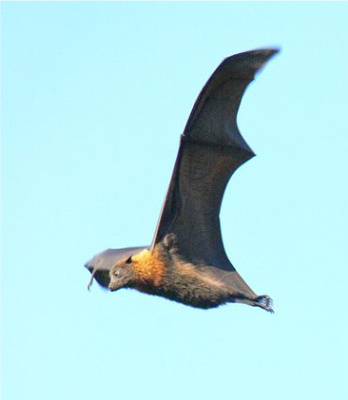 Large flying fox. Photo by: Daniel Vianna. |
Hunting has occurred for thousands of years in Southeast Asia, yet few species are known to have faced extinction from it. Then in the Twentieth Century something changed.
“Accessibility of both forests and markets” has transformed hunting from sustainable killing for food to widespread commercial destruction, according to Corlett, who adds that “subsistence hunters have no incentive to track down rare species, but markets compensate for the extra effort by paying more.”
While Corelett describes China’s black market for animal products as “huge”, he adds that China “is not the only Asian consumer of wildlife”.
To combat the wildlife trade, Corlett says that enforcement of existing laws is key, as well as new laws to save unprotected species like the large flying fox.
Corlett has also proposed an innovative idea to tackle hunting in which local communities would be compensated for protecting biodiversity, and the ecosystem services that the species provide. He imagines that communities “would be paid an annual sum tied to the abundance of vulnerable wildife, such as gibbons or tigers, giving them an incentive to control hunting. But this will only work if social networks are strong enough to prevent cheating and if the villagers can keep out outsiders.”
In a November 2009 interview Mongabay.com spoke with Richard Corlett about the importance of seed dispersers, the continuing threat of hunting to species and forests, and ways to turn back the tide on Southeast Asia’s hunting crisis.
INTERVIEW WITH RICHARD CORLETT
Mongabay: What is your background?
Richard Corlett: I am from London and first became interested in the tropics while an undergraduate at Cambridge, where a friend and I got funding to carry out research in Malaysia in the summer holidays. I then did my PhD at the Australian National University with fieldwork in the highlands of Papua New Guinea. Since then I have lived in tropical Asia, teaching first at the University of Chiang Mai, in northern Thailand, then at the National University of Singapore, then at the University of Hong Kong for 20 years, and now back in Singapore as Professor of Terrestrial Ecology.
Mongabay: Most biologists like to study the most pristine ecosystems available. What led you to study the ecology of deforested and degraded tropical landscapes?
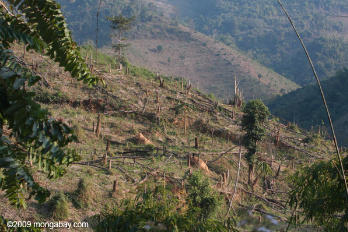 Deforestation in Laos. Photo by: Rhett A. Butler. |
Richard Corlett: If you live outside the tropics and do research only while on expeditions it makes sense to visit the most pristine sites available. But I have lived in the tropics for 30 years, teaching at universities in deforested and degraded landscapes, so it has been natural that I study the areas around me. It is important that we know what survives and what doesn’t, and as these landscapes expand at the expense of pristine ecosystems it becomes increasingly important that we learn how to modify them so that they can support more native species. Most research in Europe takes place in equally deforested and degraded landscapes, but the authors rarely mention this – and, indeed, may not even be aware of it!
Mongabay: You have lived in Asia for many years, both Singapore and Hong Kong. How have the tropical ecosystems changed in the time you’ve been there?
Richard Corlett: Not so much in Singapore and Hong Kong, which were highly developed when I first visited them, but the destruction and degradation of forest ecosystems in tropical East Asia has a whole over the last 30 years has been simply appalling. Thirty years ago there were still large, near-pristine areas with more or less intact faunas: now almost everywhere is degraded and even the best-looking forest has lost some or all of its large vertebrates to hunters. Developing countries needed to trade some forest for development, but inefficencies and corruption have made the process much more destructive than it needed to be. Much of the destruction has benefited only a few individuals and done nothing to lift the majority of the population out of poverty.
SEED DISPERSING
Mongabay: What is the role of seed dispersers-birds, bats, rodents, and some large mammals-in the Asian tropics?
Richard Corlett: All plants need seed dispersal agents but the importance of animals (rather than wind) increases in the tropics, reaching a maximum in the tropical rainforest where around 80 percent of trees, shrubs and climbers are animal dispersed. In the Asian tropics, birds are most important, followed by primates and fruit bats, civets, and a variety of terrestrial herbivores, including elephants, rhinoceroses, tapirs, and deer. Rodents are probably important too, but have been studied very little in this region.
Mongabay: Why are seed dispersers especially important in the face of climate change?
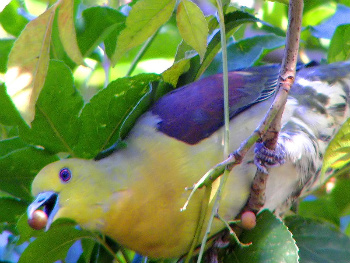 White-bellied green pigeon feasting on fruit. Photo by: Charles Lam. |
Richard Corlett: As the climate changes, plant populations must adapt, move or die, and seed dispersal is the only way to move. Outside the tropics many plant species have moved towards the poles or to higher altitudes as a result of warming over recent decades. Changes within the tropics have so far been relatively small, but the much larger changes predicted for the next 50-100 years will almost certainly require tropical plant populations to migrate.
Mongabay: Which seed dispersers are able to carry plant species far enough for them to adapt to a warmer world?
Richard Corlett: In very steep topography a species need only move a kilometer or two to compensate for 2-3 degrees of warming and many animals can move at least one seeds this far. In the lowland tropics, however, climate gradients are very shallow and species may have to move 100s of kilometers to compensate – probably an impossible task without human intervention.
Mongabay: You point out that two types of Asian seed dispersers are particularly important: large fruit bats and fruit pigeons. What makes these species unique?
Richard Corlett: Both regularly move seeds over distances greater than a kilometer and at least sometimes move them more than 10 km. This sort of distance can bridge gaps between forest fragments in human-dominated landscapes, which other potential long-distance dispersers, such as elephants, will not cross. Fruit bats only do this for tiny seeds, since they drop larger ones at “feeding roosts” near the fruiting tree, but fruit pigeons can swallow huge seeds – although we don’t know for sure how far they will fly when weighed down by these. Unfortunately, both are heavily hunted at present.
HUNTING IN SOUTHEAST ASIA
Mongabay: Hunting has been going on in Southeast Asia for millennia and there have been few recorded extinctions. What has changed recently?
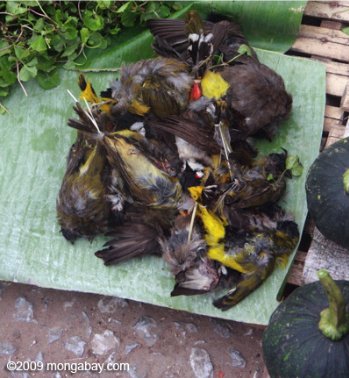 Dead songbirds sold for food in Luang Prabang market in Laos. Photo by: Rhett A. Butler. |
Richard Corlett: Accessibility of both forests and markets. Subsistence hunters have no incentive to track down rare species, but markets compensate for the extra effort by paying more.
Mongabay: What role does China play in hunting across Southeast Asia?
Richard Corlett: Huge as a market for species that are seen as health foods – such as pangolins – and/or have specific roles in traditional medicine. In practice, this includes hundreds of species and their parts. But China is not the only Asian consumer of wildlife and there have been some recent efforts at cracking down on the trade.
Mongabay: What is the link between hunting and seed dispersers?
Richard Corlett: The most-hunted species in tropical Asia are almost all important seed dispersal agents, with pigs and pangolins the major exceptions. Hunters favor larger species that can move bigger seeds longer distances. Most surviving forests in the region have now lost most or all of their largest frugivores (fruit-eaters), or the survivors are too rare to disperse many seeds.
Mongabay: A recent study found that the large flying fox (the world’s largest bat) could face extinction in 6-81 years due to LEGAL hunting. Does this finding surprise you?
Richard Corlett: Not at all, but it is depressing. The decline in flying fox populations is one of the most conspicuous changes in the region in the 30 years I have been here.
Mongabay: What other ecological roles do hunted species play in the life of the forest?
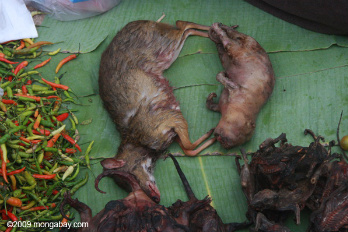 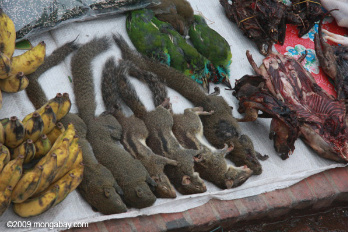 Top: mouse deer and rodents sold as bushmeat. Bottom: birds and squirrels for meat alongside bananas. Photos by: Rhett A. Butler. |
Richard Corlett: All the roles played by vertebrates: seed predation, browsing, pollination, predation, scavenging.
GOING FORWARD
Mongabay: What actions would you recommend to save ecologically important species from over-hunting?
Richard Corlett: 1. Enforcement of existing laws in protected areas and in local and regional markets. 2. New legislation protecting key species (e.g. flying foxes) outside protected areas.
Mongabay: Why do you think many Asian countries have not been able to provide effective law enforcement regarding hunting and trapping?
Richard Corlett: I don’t think it has been seen as big a problem as deforestation and logging. Plus it is seen as a sensitive livelihood issue, despite the fact that it makes a very minor contribution to subsistence in the region.
Mongabay: Do you think education programs or greater awareness of how hunting impacts the forest could lead to changes in the demand for medicines and meat from wildlife?
Richard Corlett: Yes, but too slowly, and enforcement is the best publicity.
Mongabay: You have recommended direct payments to local communities in relation to their wildlife abundance. Can you explain this concept? What are the advantages/disadvantages?
Richard Corlett: I have recommended trying this – I am not sure if it would work. The idea would be that a local community would be paid an annual sum tied to the abundance of vulnerable wildife, such as gibbons or tigers, giving them an incentive to control hunting. But this will only work if social networks are strong enough to prevent cheating and if the villagers can keep out outsiders.
Mongabay: If hunting is not better managed what will Asia’s future forests look like?
Richard Corlett: Empty, and increasingly dominated by plant species that are dispersed by wind or the ubiquitous small frugivorous birds and fruit bats.
Related articles
World’s largest bat threatened with extinction due to legal hunting
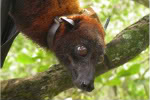
(08/25/2009) Under the current legal hunting rate scientists predict that the world’s largest bat, the aptly-named large flying fox or Pteropus vampyrus, faces extinction in six to 81 years. Increasing the urgency to save the large flying fox is the vital role it plays as an ecosystem engineer (a species whose behavior can shape an ecosystem); the species maintains Southeast Asian forests by dispersing a wide variety of seeds over distances farther than most birds and other mammals.
War and conservation in Cambodia
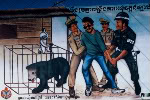
(06/21/2009) The decades-long conflict in Cambodia devastated not only the human population of the Southeast Asian country but its biodiversity as well. The conflict led to widespread declines of species in the once wildlife-rich nation while steering traditional society towards unsustainable hunting practices, resulting in a situation where wildlife is still in decline in Cambodia, according to a new study from researchers with the World Wildlife Fund (WWF).
Tropical East Asian forests under great threat

(06/02/2009) Tropical East Asia’s rapid population growth and dramatic economic expansion over the past half century have taken a heavy toll on its natural resources. More than two-thirds of the region’s original forest cover has been cleared or converted for agriculture and plantations, while its flora and fauna have suffered dearly from a burgeoning trade in wildlife products—several charismatic species have gone extinct as a direct consequence of human exploitation. Nevertheless tropical East Asia remains a top global priority for conservation, supporting up to a quarter of the world’s terrestrial species.
Vietnam’s commercial wildlife farms threaten Asia’s species

(05/22/2009) Commercial wildlife farms are not alleviating pressure on wild populations as claimed by proponents, but exacerbating the problem according to a new report by the Wildlife Conservation Society (WCS) and Vietnam’s Forest Protection Department. Such farms, which rear snakes, turtles, crocodiles, tigers, monkeys, and other—often rare—species, are meant to provide customers throughout Southeast Asia with legally produced ‘wild’ meats and other products.
Illegal hunting in Laos takes toll on wildlife

(04/20/2009) Deep in the rugged mountains of Nam Et-Phou Louey National Protected Area (NEPL) on the Laos–Vietnam border, men smoke cigarettes and talk in hushed voices as they tramp through the forest. Approaching a baited trap, they hear the frantic snarls of an ensnared tiger. The tiger hangs by its front foot, suspended by a cable attached to a tree. The men shoot and make quick work of the tiger, removing its bones but leaving some of its carcass, including parts of its pelt, behind. The real money is no longer in tiger skins, but bones: the 10 to 12 kilograms of bone harvested from the adult tiger will yield $12,000-$15,000 in a region where per capita income is around $400 a year. Though the authorities are able to trace the weapon shells back to their village and locals know of the hunters’ haul, two years later the evidence has not been enough to hold the men accountable for their crimes.
YouTube videos may be imperiling cuddly primate
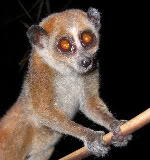
(02/24/2009) Many “cute” and “cuddly” species have gained attention and funds from conservation groups, since the public gravitates toward such attractive species. In fact, cuteness can sometimes mean the difference between conservation attention and extinction. However, for slow lorises being cute may be their downfall. Despite the fact that owning a slow loris as a pet or trading it is illegal in all range countries and “all countries where primates as pets are illegal,” the species is still heavily trafficked, says Dr. Anna Nekaris, an anthropologist who specializes in slow-loris research at Oxford Brookes University. During the past few years videos of pet slow lorises have begun to appear on YouTube. Such videos often include comments from users who push misinformation about the slow loris’s legality and aptitude as pets, raising concerns among conservationists that the videos encourage people to actively pursue the slow loris as a pet.
High ivory prices in Vietnam drive killing of elephants in Laos, Cambodia
(02/19/2009) Indochina’s remaining elephants are at risk from surging ivory prices in Vietnam, according to a new report from the wildlife trade monitoring network TRAFFIC.
Wildlife trade creating “empty forest syndrome” across the globe

(01/19/2009) For many endangered species it is not the lack of suitable habitat that has imperiled them, but hunting. In a talk at a Smithsonian Symposium on tropical forests, Elizabeth Bennett of the Wildlife Conservation Society (WCS) outlined the perils for many species of the booming and illegal wildlife trade. She described pristine forests, which although providing perfect habitat for species, stood empty and quiet, drained by hunting for bushmeat, traditional medicine, the pet trade, and trophies.